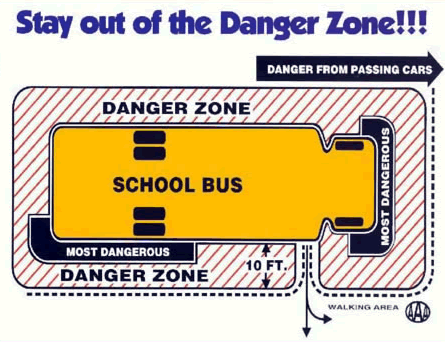)
Keeping Students Safe
Student safety is the primary concern of the Transportation Department. Statistics show that the most dangerous time for students is before they get on the bus and after they get off the bus. The Transportation Department considers the environment and age of the students when placing bus stops. We attempt to place every bus stop at a location with reasonable safety assurances for students. Parents must assume the responsibility for their children while traveling back and forth from home to the stop.
Yellow school bus transportation is the safest, most economical and friendly method of transporting Arizona's school children. According to the National Safety Council yellow school buses are:
- More than 150 times safer than your family automobile
- 8 times safer than passenger trains or commercial airlines
- 4 times safer than transit buses or intercity buses
Bus Stop Locations
Dysart Unified School District creates bus stops using the following criteria:
- Reduce students crossing busy streets at elementary levels except where staffed or indicated by clear marked crossings and reduce the number of students crossing at secondary levels.
- Provide students with the ability to stand off the roadway while waiting for the bus.
- Locate the stops to maximize visibility for both students and traffic (100' minimum visibility).
- Avoid locations that expose students to traffic hazards and reduce the number of hazards for students crossing the street.
- Place the stops in locations away from non-traffic hazards such as railroad tracks and commercial areas.
- Place the stops at least 50 feet away from corners, if possible, to better control traffic in the area immediately around the bus.
- Place stops on streets with as little traffic as possible.
- Create a buffer zone between students and the bus both in the neighborhoods and at school to keep students from being struck by the bus.
School Bus Danger Zones
The most dangerous time for a student riding the school bus is the loading and unloading process. It is critical that students are visible to the driver and out of the bus danger zones when the bus is in motion. This rule applies to loading and unloading both in the neighborhoods and at schools. If students are crossing the street, they should move immediately out of the danger zone and proceed at least 10 feet in front of the bus and wait for the drivers signal before crossing the street.

In order to become a school bus driver in Arizona, a person must meet very specific requirements set forth by federal and state law. Drivers for the Dysart Unified School District are expected to maintain discipline while operating the bus in a safe manner and, as such, have received several types of training. In addition to behind-the-wheel training, drivers are required to attend ongoing instruction, show proficiency in first aid/CPR, and be able to manage student behavior. Drivers transporting medically fragile children or those with handicapped conditions receive additional training in the care and management of these children. Bus emergency evacuation drills are conducted twice a year to ensure that students know how to respond in an emergency.
The transportation staff is dedicated to providing the safest transportation for your child. The Dysart Unified School District covers 145 square miles and operates 19 elementary and middle schools and 4 high schools. The transportation department presently operates 153 buses, that drive 7,100 miles a day, picking up over 6,000 students each day. These buses stop multiple times (totaling 400 stops) on multiple routes (totaling 115 routes) while picking up or dropping off students each day. These stops are during rush-hour traffic and, although we do not plan for late buses, this does happen due to traffic congestion (railroad crossings), accidents, construction, and student discipline. We ask for your patience and understanding as we strive to provide the best possible transportation solutions.